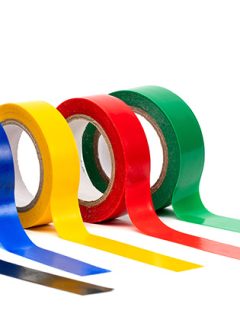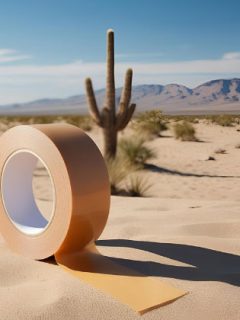Cushioning material such as bubble wrap plays one of the most important roles in the packaging process – it protects the product from bumps, dents and shocks so that it arrives at its destination intact and undamaged. An essential material in this area has always been bubble wrap. It’s light, strong, soft, easy to work with and offers amazing protection for almost anything – plus it’s great fun to make it pop, which incidentally has a very stress-relieving effect. In this post we focus on bubble wrap in detail; we look at how it is made, how it was invented, how it can be used for packaging and how to recycle bubble wrap.
How is bubble wrap made?
Bubble wrap is made from tiny beads of resin, almost as small as grains of rice. Different resins are used for their different properties and combined to make the material we know and use as bubble wrap.
The tiny resin beads are melted at over 450 degrees Celcius, they combine and a thin film is formed which then forms the base material for making bubble wrap. The film is flattened to the desired thickness before being passed through rollers with small holes (a negative mould with dimples already punched in the size of the later bubbles).
As the film moves over these rollers, air is sucked in and blown into the dimples, these are the later air bubbles that give the bubble wrap its good protective properties.
The film is then passed over further rollers which seal it with an additional layer of film, trapping the air inside – the famous air nubs are born.
Finally, it is cut to width and perforated so that it can be rolled up into large, industrially produced rolls. After passing quality control, it is then shipped all over the world.
Making bubble wrap
Step 1: The negative mould
Above in the first image from the left: In a molten, viscous state, the plastic is poured onto a wide roll which, as a negative mould, already has punched depressions in the size of the later studs.
Step 2: Pouring over the roller
Second picture: When pouring over the roll, a flat, smooth film layer is formed from the plastic.
Step 3: The film is sucked in
Third picture: By means of a vacuum, the hot plastic is sucked in through the depressions, so that the film gets its dimples here.
Step 4: The foils are sealed
The film is sealed with an additional film layer, trapping the air inside.
The invention of bubble wrap
In 1957, bubble wrap was discovered by accident by two American engineers Alfred Fielding and Marc Chavannes, they were actually looking for a new plastic wallpaper that was easy to wash and apply. In 1959, they applied for a patent for the packaging material thus discovered and founded the Sealed Air Company.
Over 50 years later, it is used all over the world and is now one of the most widely used packaging materials.
The FAQ on bubble wrap:
Is bubble wrap recyclable?
Bubble wrap is recyclable! This amazing material is not only highly protective, but also recyclable! But what does that mean exactly?
For the recycling process, the material is collected from private households or public places, depending on the catchment area. Afterwards, 95% of the waste is separated by type in a fully automated sorting process. In Germany, about 73% is then recycled. If recycling is not possible, the material is used to generate energy. If you have any further questions about waste separation, which is a prerequisite for high-quality recycling, your local waste advisory service can help. The NABU has an overview of local waste advice centres, simply enter your postcode and contact the relevant office.
How do you use bubble wrap for packaging?
During transport, many external influences act on a product. Bubble wrap can be used in many ways to pack and protect, as it protects against impact and abrasion but also provides protection against moisture, as it is weldable and waterproof.
Which side with the bumps?
Bubble wrap has a flat side and a side with the cushioning bubbles. A common question we are asked:
“Which side do you use to provide the best protection?”
We always recommend wrapping the bubbles around the item you want to protect, which usually means the bubbles are on the inside. This provides the best protection, as the bubbles serve to absorb mechanical shocks
How exactly is bubble wrap used to protect and cushion items?
To protect individual items in boxes from bumps and dents, bubble wrap is placed around each item before it is placed in a Cardboard or box around each item.
Use Packing tape to secure the bubble wrap around the item you are packing and seal it tightly. This will ensure that you get the maximum protection possible with the cushioning material. If it is only loosely wrapped, it can slip during transport and the product may no longer be adequately protected.
Bubble wrap is ideal for protecting sensitive items such as individual bicycle parts.
How exactly is bubble wrap used to separate and secure items?
If you are shipping packages with multiple items inside, bubble wrap can also be used to layer or separate, creating a soft layer of air cushioning to prevent products from moving loosely during transport. Divide the bubble wrap into squares, and you can then place them in the package between the items for cushioning.
Other bubble wrap is also available to protect smaller, fragile or delicate items in transit or during storage. Bubble bags offer excellent protection for delicate items and provide all-round cushioning and protection. They are great for use with an envelope or box and provide an extra layer of protection.
What is meant by barrier pimples?
Bubble films with a barrier layer are particularly resistant: the PE film is co-extruded in these, which means that a barrier layer is already processed within the PE film, which allows almost no air to pass through. This enables a long-lasting impact protection effect, as the air remains in the studs for a long time. Normal bubble pads without an integrated nylon barrier layer lose air over a longer period of time. As a result, the damping effect diminishes over time.
Which nub size for what?
In addition to green bubble wrap and anti-static bubble wrap, there are various special shapes. The size of the bubbles, for example, varies depending on the intended use: the larger the bubble diameter, the more air is present as padding. If there is more air inside the bubbles, the bubble height also increases – and so does the protective effect. This is because large nubs can absorb stronger impacts than small nubs.
Small bubble films have a bubble diameter of approx. 10 mm. As a standard size, the nubs have a height of 4 mm. It is particularly suitable for sending light to medium-weight, sensitive products.
Large-nap bubble films have a nap diameter of approx. 25-30 mm, but there are also nap diameters between 10 – 25 mm. Compared to small-nap film, the nap height is greater, more “air” means greater protection. It is therefore particularly suitable for medium to heavy and sharp-edged products.
What are the benefits of three-layer bubble wrap?
In addition to the standard two-ply bubble wrap, there is also a three-ply version. A second lidding film is applied to the two-layer plastic described at the beginning. This makes the film more resilient than two-layer bubble wrap. Additional protection can also be applied to achieve reinforcing properties.
Structure of the bubble wrap, two or three layers:
This is the benefit of adding another layer to bubble wrap:
Increase strength
If the film is to be made more stable, a third layer, for example of paper, can be useful. For example, with a bubble wrap with a paper backing:
A bubble wrap can thus be reinforced with another layer. This further layer can be made of different materials. For a particularly stable film, kraft paper can be used as a further layer; in this case, the paper layer is attached to the side of the bubble opening in the finished bubble wrap.
Increase surface protection
For surface sensitive products against scratches, there is the possibility to use a bubble wrap with fleece coating. The non-woven coating usually consists of chemical non-woven fibres, i.e. plastics are used as the fibre base. The nonwoven acts as a protective contact surface to the sensitive product surface. Here too, the strength of the 3-layer bubble wrap is increased by the 4th layer of fleece. Compared to bubble wrap with paper coating, bubble wrap with PP fleece is more flexible.
Antistatic effect
Bubble film with antistatic effect is available especially for the packaging of electrical components or products. In this case, the bubble films are already combined with antistatic agents during production. Antistatic agents are additives that are already mixed into the plastic granulate before the film is produced. These additives go to the outer surfaces of the film during film production and attract substances to the outer surfaces that conduct electricity better. In this way, the products can be protected from becoming electrostatically charged (happens, for example, through friction). This is because electrostatic charging can cause electronic products to suddenly discharge electrically. Electrostatic discharge (ESD) (= high electrical voltage pulse) can cause damage to a product. This can be particularly useful for electronic assemblies.
So bubble wrap is a packaging material of almost unlimited possibilities!
Which bubble wrap is the right one depends on 3 factors: the product shape, the product weight and its sensitivity.
- Shape: if the product is sharp-edged, for example, then large-nap films are recommended.
- The weight: for heavy products, large-nap films are more suitable. For shipping light to medium weight, delicate products, the small nubbed bubble films are optimal.
- Sensitivity: if, for example, the product has a sensitive surface that needs to be protected from scratches or if electronic parts are packed that need to be protected from electrical charge, bubble films with additional properties are required.














